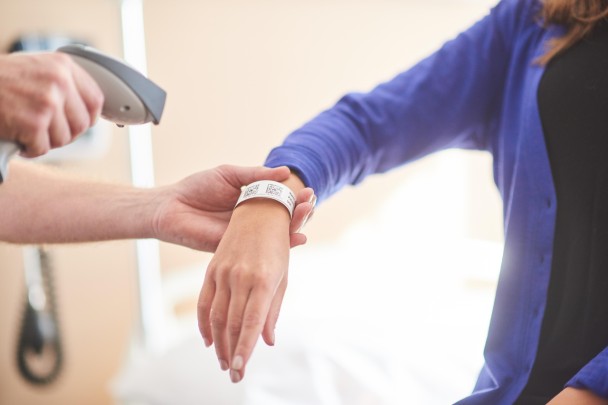April 14, 2022 Industry news

Product data captured directly into inventory management system
What is AIDC?
Using technologies such as barcodes and radio-frequency identification (RFID), Automatic Identification Data Capture (AIDC), allows for the accurate and efficient capture of data directly at the point of care or use. This could be data pertaining to a person (patient or staff member), product (medical device, medication, or asset), or place (an organisation or location).
The application of AIDC has seen increasing adoption in healthcare. By automating data capture, AIDC is driving efficiencies, improving data accuracy and reducing the burdens on healthcare providers and their staff.
GS1 standards play a vital role in AIDC and are used to uniquely identify people, products, and places. This data is then encoded into barcodes or RFID tags, which are then used to enable the automated capture of that data.
As well as boosting efficiency, AIDC has been proven to improve safety and traceability throughout the healthcare supply chain and patient pathway. Examples of its application include, medication administration and dispensing, asset management, and patient identification to name a few.
What is DAPB0108?
The AIDC standard provides the specification and guidance for achieving accurate AIDC across the NHS. This standard applies to any NHS setting in England where AIDC technologies are used as enablers to improve patient safety, ensure greater clinical effectiveness, and drive operational efficiencies.
What are the changes?
The updated standard will include details on the following GS1 standards that were previously not present, or that have been developed since the standard was first published.

GSRN patient wristband for DCB1077
The changes* applied are as follows:
- Serialised Global Trade Item Number (SGTIN): Enables a more granular level of identification of products or assets i.e. instance level, rather than product level
- Service Relation Instance Number (SRIN): Enables the enables identification of specific episodes of care, added as extension to Global Service Relation Number (GSRN), aligning to DCB1077: AIDC for Patient Identification
- Global Model Number (GMN): Used as the Basic UDI-DI (BUDI-DI) for unique identification of implantable device model types, addressing various international Medical Device Regulations
Does this update apply to me?
This amend applies to NHS settings in England where AIDC technologies are currently used.
If you are starting to, or looking to start using AIDC, or are embarking on a Scan4Safety project, you must conform to the specifications outlined in this standard.
It should be used by all NHS organisations when procuring, implementing, and using any such technologies.
The users of the standard will be those involved in the procurement, deployment, and use of AIDC systems using GS1 standards across the NHS in England, as well as those associated with the provision of patient care, i.e., healthcare professionals.
These may include:
- IT and informatics personnel
- Finance and procurement
- Departmental directors and managers
- Project managers
- Healthcare professionals
- Administration staff
- Estates
What do I need to do now?
If you are already using AIDC technologies, please refer to the NHS Digital guidance.
If you are not yet using AIDC but have a plan to start, you will need to ensure you have your unique GS1 Company Prefix (GCP). This will provide you with the baseline numbers required to produce your organisation’s unique identifiers. To find out yours, contact a member of the GS1 UK healthcare team.
Where can I get some further information?

Helpful resources
Further information can be found on the GS1 UK website via our resources page. You can also find details of the changes on the NHS Digital website here.

Find a training course
We also provide helpful training courses to keep healthcare providers, suppliers and solution provides up to date with GS1 standards. Take a look at our training offering.

Get in touch
For anything in between, you can contact a member of the GS1 UK healthcare team who will be able to help. Email us to get in touch.
*This guidance has been updated between NHS Digital's Data Alliance Partnership Board (DAPB), and GS1 UK's standards and consultancy team. Contributions to the updates come from Alex Elias, associate director for information standards and information representation services at NHS Digital, and John Papadopoulos, standards and consulting at GS1 UK.
